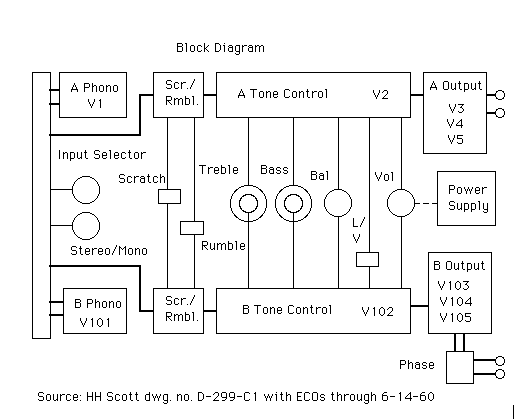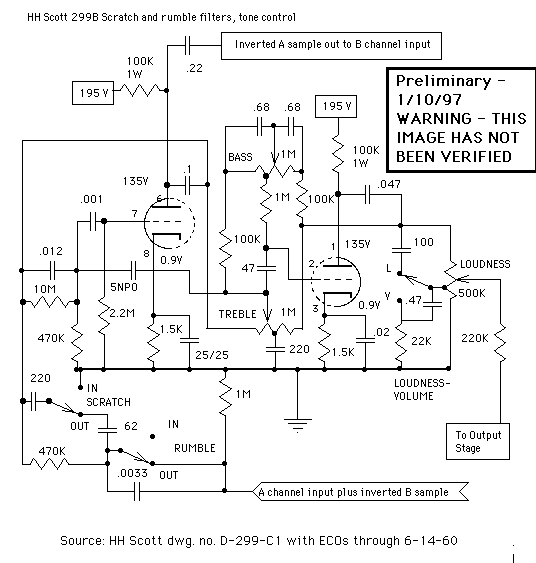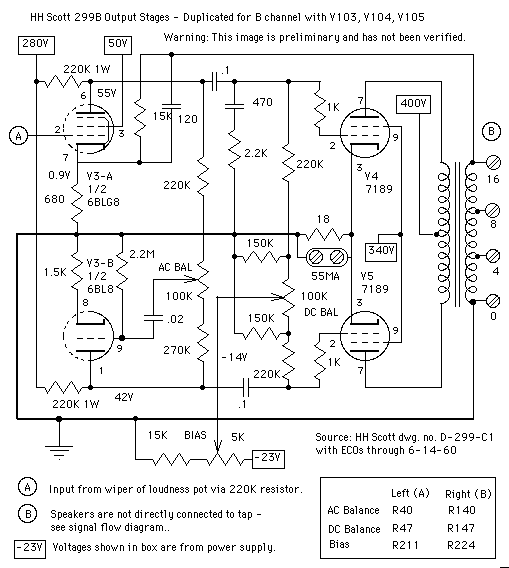| |
|
|
|
Audio high fidelity is a subjective matter, in that one listener's preference may be to another listeners disliking. This is especially true of speakers. Also, a given suite of equipment will sound different in different environments.
Tube audio equipment can have voltage potentials exceeding 700 volts AC. If you intend to perform internal maintenance (other than tube replacements on unplugged equipment) you should learn and follow all precautions for high voltage electrical work. Most audio equipment will be safe when unplugged but some may retain high voltages even then. Tubes can get very hot (especially if the circuit is not operating correctly) and burns are a hazzard.
Electron tubes are thought by many to be well suited for high fidelity audio applications. Technical observers report that when a tube amplifier is operated near its power limits that the distortion produced is the addition of even harmonics (even multiples of the fundamental freqency), while transistor amplifiers produce a distortion consisting of odd harmonics. Many listeners think that the addition of even harmonics is acceptable and even pleasant, while finding odd harmonics are harsh and disturbing. The addition specific proportions of even harmonics to a pure sine wave will produce a sawtooth wave, which has a timbre similar to a reed instrument such as a clarinet, while a similar addition of odd harmonics will produce a square wave, percieved as a harsh buzz, similar to the sound of a kazoo. Click here for a diagram of harmonic addition. On loud transients, the current capacity of the tube and a tube-rectified power supply will limit with a gradual fall-off, where solid state will "clip", introducing harsh high frequency components that can even damage speakers. Thus many solid state amplifiers are overbuilt, with extra capacity to avoid the introduction of this distortion under conditions rarely encountered. Tube amplifier watts are said to be "bigger", in that under extreme conditions a given musical passage will sound better on a tube amplifier than on a solid state amp of the same wattage. Modern mass market solid state equipment is now built to meet specific manufacturing cost targets. (Some think that there was a "golden age" of Japanese solid state equipment around the 1980's, when the technology was mastered and engineers rather than accountants still ruled.) It has been my experience that an old mid priced tube amp sounds much better than modern mid priced solid state equipment (using the same speakers and source), especially in the way that instruments in a symphony orchestra's string section will retain their individual identities, rather than being muddled together.
There is modern production of tubes and tube equipment and there are shops around capable of servicing both old and new units.
Modern replacements for many of the more common tubes are readily available at reasonable prices. At the time that tube electronics dominated high end audio, speakers with both high fidelity and high efficiency were rare, and so audiophiles felt the need for power, with mid range (and mid price) equipment not getting the respect now deserved when driving modern high efficiency speakers. Now, old equipment of modest wattage can produce much more quality sound than was typical in its time.
Tube equipment was replaced with solid state because solid state answered the following disadvantages of tubes, most of which are critical in military and industrial applications:
Tubes require a warm-up time, typically 20 to 40 seconds before useful output is obtained and up to twenty minutes before circuits reach a steady state.
Tubes are sensitive to shock and vibration, which can affect both durability and performance.
The high voltages used require use of larger and more expensive capacitors and adds stress to the winding insulation of power supply and output transformers.
Tubes produce considerable heat which can shorten the life of other components in the device.
Designing for disposal of the heat produced restricted the design of equipment enclosures, requiring bulky box shapes for equipment. This heat leads to low efficiency in terms of audio watts produced for wall plug watts consumed. Tube equipment efficiency is especially bad at low levels of output since cathode heaters consume constant power regardless of the device's output.
Tubes have a limited life. Several thousand hours of use is typical. Many on and off cycles will further shorten tube life, thus a tube set may be left on when not in use, further degrading overall efficiency.
Tube equipment, particulary power amplifiers, can have deadly high voltages and high stored energy (even when unpluged, in some cases), and should be worked on only with knowledge and use of safety procedures.
Tube characteristics change with use and in some equipment this change should be periodically compensated for by adjustments for best fidelity, efficiency, and component life. Adjustment may be required when certain tubes are replaced, while some lower power amplifiers require no such adjustment. Adjustment requires the use of at least simple test equipment and elementary knowlege. Radio tuning circuits will require adjustment using specialized equipment and knowlege when certain tubes are replaced.
Older equipment may use components that are difficult to obtain. This can usually be compensated for by modifying circuits to use more readily obtainable parts.
Tubes are bulky compared to transistors.
You can't make an integrated circuit using conventional tube technology, although there have been experimental efforts to design and construct microstructure cold-cathode vacuum devices that would be suitable for operating in high radiation environments that can damage solid state devices. These microstructures are produced using the lithographic deposition and etching techniques developed for the manufacture of integrated circuits.
Electron tubes have an interesting recent history. Tubes (what the speakers of British English call "valves") were for an extended period were the only economical means of amplifying analog electrical signals (and thus useful in radios and high fidelity amplifiers). They were thought obsolete in the West when their functions could be efectively done by transistors. The Soviet Union, however, continued to use them in military electronics. This was thought by western analysts to be due to an inability to produce transistors and integrated circuits of the quality necessary for such application, but in reality their use by the Soviet Union was based on the fact that electron tubes are radiation-hard, becoming fully functional seconds after a nuclear blast. The high currents induced by the magnetic pulse produced by an atomic blast and ionizing radiation can permanently destroy transistors and integrated circuits.
As a consequence of this recent use of these devices, modern factories within the former Soviet Union, China, and Eastern Europe continue to produce tubes and are a primary source of electron tubes for replacement and use in newly manufactured audio equipment. The quality and durability of tubes is said to vary, however, with some countries having a far better reputation than others. Caches of "New Old Stock" (NOS) tubes are sometimes found as old electronic shops change hands and some brands are treasured by tube audiophiles, but sometimes modern low quality tubes are remarked or repackaged to look like NOS. Also, some cheap rectifier tubes are "pin compatable" with original tubes and are labled with the same designation but are not the same internally and can damage the amplifier. These lack a cathode envelope around the heater and thus warm up too fast, shocking other components with high voltage befor they are warmed up and causing "cathode stripping" and other problems. (BEWARE!)
Modern tube audio equipment of new manufacture is now a specialty shop item. Some retailers sell only tube equipment. Modern amplifiers are now styled to show off their tubes and transformers whereas older equipment kept such things "under the hood". To obtain, refurbish, and maintain old tube audio equipment can be either a major hassle or an enjoyable and rewarding hobby - it all depends upon your outlook, interests, and skills. Price of older equipment will vary greatly, being dependent on brand, condition (particulary cosmetics), factory vs kit built, and the knowlege and interest of the buyer and seller. Thrift shops and garage and estate sales can sometimes reward the careful and persistant shoper with a real bargain, but such equipment usually requires careful initial warm up and often extensive replacement of components.
Some professional equipment builders produce new designs while using the power and output transformers from older equipment. The transformers are the most expensive components of tube equipment. This is a particularly effective way to recycle obsolete integrated monophonic equipment into single channel amplifiers (monoblock) or stereo or multichannel integrated units.
Other than bad tubes, typical problems with old used equipment will be overheated resistors and wiring due to operation excessive current from tube operation out of the proper bias range. This is often due to (electrically) leaking coupling capacitors. If you cannot adjust the tube current to the proper level or if your equipment is self biasing but the output tubes run hot, you probably have leaking coupling capacitors. These can easily be replaced with a little knowlege and the usual safety precautions. When replacing interstage coupling capacitors, always use the same capacitance, but a higher voltage rating will not hurt. Often resistors are out of specification and performance can be greatly improved by replacement, particularly in the phase splitter circuit that drives the final amplifier tubes. Leaky capacitors in intermediate stages can also cause plate and cathode resistors to run hot and go out of specifications.
If old equipment (tube or transistor) has not been operated for a long time, operation can cause catastrophic failure of electrolytic capacitors. Such equipment should be brought into operation at low voltage using a variac (variable A/C transformer), warming up gradually over a 20 to 30 minute period.
For long life, keep your equipment clean and dust free and at least once a year perform any required adjustments. Many units require a bias adjustment to preserve tube life, reduce heat, and keep the best sound reproduction. This will usually require modest test equipment, knowlege of the equipment in question, and the usual safety precautions.
This amplifier is representative of mid wattage high fidelity units of the 1950's and 60's. It is an "integrated" amplifier in that it contains signal selection, preamplification, and tone controls in one unit. Such units were not taken as seriously at the time by audiophiles as were separate components, while in fact there is no performance difference if the unit was properly designed and is in good operating condition. The 299B model's specifications include a rated output of 25 watts per channel. This is a distinct step up from console equipment typically found in mass market retailers at the time and can produce audiophile quality sound at practical listening levels. The 299C and later are similar but produce 35 watts per channel with different output tubes and other components.
This unit's power supply uses a 5AR4 octal base rectifier producing 405 volts before filtering. All amplifying tubes are seven and nine pin miniatures (the glass envelope forms the base and the tube pins are wire). Tubes in the 299C are four 12AX7 dual triodes (for phono amp and tone control), two 6BL6 triode/pentode combo used for output driver and inverter, and four 7189 power amps in push-pull, for a total of 11 tubes. The 299B uses 6BQ5/EL34 output tubes) The low level circuits all use filtered DC on the cathode heaters for hum elimination. The unit is well engineered and uses a good proportion of high quality components at critical points. Like most of the equipment in its price range it makes extensive use of lower cost components in non-critical applications and has an aluminum chassies.
This is typical of any integrated stereo amplifier, tube or solid state.

Eratta: The tape monitor controls are not shown.

Eratta: The bass control capacitors should be .0068 microfarad, not 68.

This work is not complete and addtional diagrams will be added as time allows.
If you are interested in current discussions of tube audio equipment, see the newsgroup "news:rec.audio.tubes".
For another site on HH Scott equipment, see John Byrns' web site at "http://www.enteract.com/~jbyrns/index.html"
Lee K Schuster maintains a site at http://hhscott.com"
There is now a mail list for Scott information email hhscott@hhscott.com. Send an empty message with "SUBSCRIBE" in the subject line.
If you have comments or questions, mail me with subject "Tube Amps" at the address shown below in the graphic
![]()
(This is to foil spambots, net spiders that collect e-mail addresses for mass mailings.) Note that our politicians won't stop spam (they could) - why not?